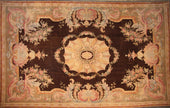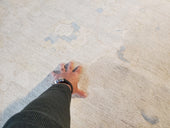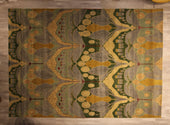Custom. Custom. Custom. It seems as though nobody just wants to buy a rug off the peg. No. It has to suit their particular taste. Once, a “custom” rug was either red or blue, in a received pattern, and the size was the only thing custom. That was that. You want a nine by sixteen Heriz? You can get it in the usual patterns and colorways. You had to order the non-standard format and trust that the weavers would get it right. That was pretty much it. Now, you go into a rug shop and explain that you want something custom. You are drawn to the racks, stacks and carousels of sample mats in a bewildering variety of types and tonalities: monochromes, bichromes; double level pile, triple level pile; mixed materials; mixed techniques; flatweave combinations; borderless and bordered; large and small patterns; horizontal or vertical linear patterns; chessboards; Art Deco styles; etc. etc. etc. Whew. And the patterns change at least annually. So how does a carpet actually happen? From the designer’s mind to your floor?

It starts with an idea in the artist’s imagination. A rough sketch is followed by more detailed drawings, with an experimentation with various colorways. These are presented to a potential buyer. A winner is chosen and a CAD (computer aided design) is created. Or the client may just skip this stage altogether and go right to an already prepared sample mat. Or a seemingly interminable selection process among many mats ensues. Finally, a definitive decision is made, and the CAD is sent off to India, or wherever, or the sample number is communicated to the distant weaving workshop. The workshop has its own sample collection and the numbers are matched. More delay. But now we are getting somewhere. Remember, that size is a quality all its own. Samplers may or may not resemble the finished product. The fall of light on a full-sized carpet will not be the same as on a sample mat. One of the most annoying banes of the custom carpet business is the complaint that the finished piece does not resemble the sample. Ugh! Assuming the sample is accepted, then what?

The trusted, competent foreign manufacturer gets the order and readies an appropriate vertical loom in their factory. Warps, generally cotton, are strung and the weavers, sitting on a bench side-by-side, with a cartoon attached to the warps in front of them,are ready to begin work. The various pattern yarns are selected from a large inventory and matched to those of the sample. Sometimes sample tufts, or their identifying numbers, are sent from the rug shop to the factory to ensure proper matches. Ideally, these are approved by the ultimate client, or, at least, by the carpet shop. Several wefts, usually cotton, are thrown to provide a basis for the work and then knotting, or whatever technique is employed, begins. The weavers compact their work, with the wefts as protection, with their beater combs.For a typical nine feet by twelve carpets of average weave, it takes about two to three months of knotting time. Flatweaves are quicker, but mixed techniques are close in working time to all-pile pieces.In mixed material pieces, say viscose silk and wool, tactile texture counts. Work proceeds if all the caveats are satisfied. The carpet is finished when the last weft rows are thrown, and the completed piece is cut down. Then the finishers begin work. General pile surfaces, as well as high/low and related sculptural, relief effects, are the work of specialized professionals working with offset scissors and drawknives. The carpet is then soap and water washed to remove grit and yarn bits. A further finishing chemical wash to precisely tone the colors may follow.

The completed carpet is then returned, usually by sea container, and the buyer can, hopefully, think that it is beautiful, appropriate and totally matches both ideal and sample. But suppose that you want something different or more?
If you want a modern carpet not available on the sample rack, a designer is engaged. A CAD is created following the initial design, and sent to the manufacturer. Presently a sample arrives, is critiqued, and probably a back-and-forth tennis-style of CADs and samples with features omitted, modified or added, ditto for colors, occurs, until the client is satisfied. Then work proceeds as above. Obviously, this process can take longer with the shippingof samples, the viewing thereof and the final cut being made. If you want such a new rug, be prepared to wait a bit.

For a custom carpet in a traditional design, the first thing is to settle on a design and type, with the relevant colors and weave. An extant carpet or illustration serves as the initial impetus, but perhaps the format or size must be altered, for example. A designer should be called in to make a sketch and follow-up CAD to make everything harmonious and proper. Since a classic prototype is being followed, close attention must be paid to the wool and dyes. A slip-up there will certainly spoil the finished creation. Good, resilient nomadic wool is essential. Dry, harsh, brittle wool is a total loser. Just because the rug is being made in India, that is no reason to accept something less than the best. Dyes, similarly, should be fitting, as if one were making the original, but with the additional passage of time and use included. Metallic, strong, unyielding synthetics are simply out of the picture. Many carpets today have returned to natural dyes, and synthetic have gotten much better. Samples showing all the colors are essential at this time. The wool of the sample should match that of the finished piece. No cheating here! Traditional carpets usually betray their handwork aspect, in unplanned adjustments, tiny additions, or little asymmetries. A modern creation should have these, even if they are planned. No single small sample mat can accommodate an entire large carpet, especially an oversize one. But lots of samples from various parts of the rug are essential: medallion, field, pattern repeat, border, corners, etc. The weavers then proceed from cartoons developed from the CADs and the above process carries over. Since most antique-style modern rugs have the pile all on one level, except for selective brown-black corrosion, the work of the finishers is simplified. The entire process takes only slightly longer than the original took. For example, a recent mansion –sized Sultanabad-style piece over 30’ long took substantially less than a year. An original of these dimensions probably required eight months. So, little time was actually lost. Custom need not mean interminable.
Now, you have a better understanding of what custom carpets take and we hope that you will take care of it as well.








